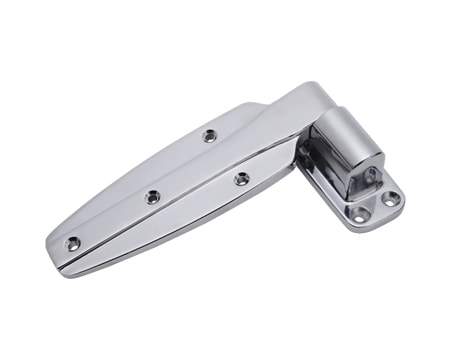Industrial hinges may appear inconspicuous, but their role in operational machinery is paramount. They ensure that equipment functions seamlessly and withstands significant loads. Their mechanics, while seemingly straightforward, are underpinned by meticulous engineering, tailored to meet the stringent requirements of diverse industries.
At their core, industrial hinges facilitate rotational movement around a designated axis, forming the pivot point. Comprising robust materials, these hinges leverage mechanical advantages, such as leverage, to support movement, all the while bearing substantial weights.
Engage further to uncover the intricate mechanics driving these hinges and the sophisticated engineering behind their apparent simplicity.

What Materials Define the Core of Industrial Hinges?
Materials play a pivotal role in determining the functionality of a hinge. In industrial applications, it’s not uncommon to find hinges made of robust substances like steel, brass, or even titanium. These materials come with inherent properties – from offering resistance to corrosion to having high weight-bearing capabilities.
Additionally, these materials can undergo surface treatments to augment their innate properties. Such enhancements can considerably prolong the hinge’s life and optimize its performance, adapting it to the specific requirements of the industrial sector it serves.
How are Hinge Designs Tailored to Load-Bearing Capacities?
Supporting heavy weights is a fundamental requirement for industrial hinges. Designs are thus tailored to harness the maximum strength of the chosen material. For instance, some of the more substantial hinges may feature a thicker pivot point or even multiple pivots, ensuring the weight is evenly distributed.
Such design nuances ensure that the hinge doesn’t undergo undue stress. Moreover, every design iteration undergoes rigorous testing, validating its efficiency and safety under varying stress levels, cementing its reliability in real-world applications.

How Crucial is Rotational Motion in Hinges?
Rotational motion sits at the heart of a hinge’s functionality. Achieving seamless rotation requires minimizing friction between the components. This is often attained using bearings or specific lubricants designed for the purpose.
The design’s primary objective is to reduce resistance during rotation and diminish wear over extended periods. This foresight ensures the hinge’s longevity and consistent performance, even under frequent use.
What Purpose do Bearings Serve in These Hinges?
Bearings play a significant role in enhancing the hinge’s movement by mitigating friction. Depending on the particular industrial application, hinges might employ ball bearings, roller bearings, or even plain bearings. Each bearing type is tailored to cater to specific operational demands, such as managing radial or axial loads.
By incorporating these bearings, hinges can promise a longer lifespan, all while reducing the need for frequent maintenance – a critical attribute for industries aiming for uninterrupted operations.

How do Hinges Handle Torque?
Torque, which represents the force inducing rotation, is a vital aspect of hinge operation. Industrial hinge designs meticulously evaluate the torque exerted during standard operations and potential overloads. To manage torque, hinges might integrate springs or similar mechanisms.
Such inclusions effectively distribute or counteract torque, ensuring that the hinge operates consistently. More importantly, it safeguards the hinge from potential damage that could arise from unexpected torque spikes.
Safety Mechanisms in Industrial Hinges: Are They Integral?
Safety is a non-negotiable in industrial setups. Recognizing this, many industrial hinges incorporate features such as stoppers, which thwart overextension. Some even feature locking systems, maintaining the hinge in a fixed position when deemed necessary.
Such safety-centric designs serve a dual purpose. Not only do they ensure the longevity and optimal performance of the machinery, but they also prioritize the safety of operators, reinforcing a safe working environment.

How do These Hinges Counteract Wear and Tear?
Every mechanical component undergoes wear over time, and hinges are no exception. Industrial hinge designs preempt this wear by opting for materials known for their wear-resistant properties. Some might even boast self-lubricating attributes or protective coatings.
Furthermore, these hinges often feature design elements that simplify regular maintenance. Whether it’s ensuring easy access points for lubrication or facilitating component replacements, these features ensure that the hinges remain in prime condition, serving their purpose effectively over the years.
Environmental Challenges: How do Hinges Rise to the Occasion?
Environmental factors can profoundly impact hinge functionality. For instance, a hinge operating in a marine environment confronts different challenges compared to one in arid conditions. The former grapples with corrosion threats from saltwater, while the latter contends with abrasive sand.
Acknowledging these challenges, hinge designs often factor in protective measures. This might entail selecting corrosion-resistant materials or integrating sealing mechanisms to fend off external adversities, ensuring the hinge’s functionality remains uncompromised.

Conclusion
Industrial hinges epitomize the confluence of design and functionality. As we delve deeper into their mechanics, it becomes evident how much thought and engineering acumen go into crafting these seemingly simple components. Ensuring durability, safety, and optimal performance, they indeed serve as the bedrock of many industrial operations.
You might also be interested:




